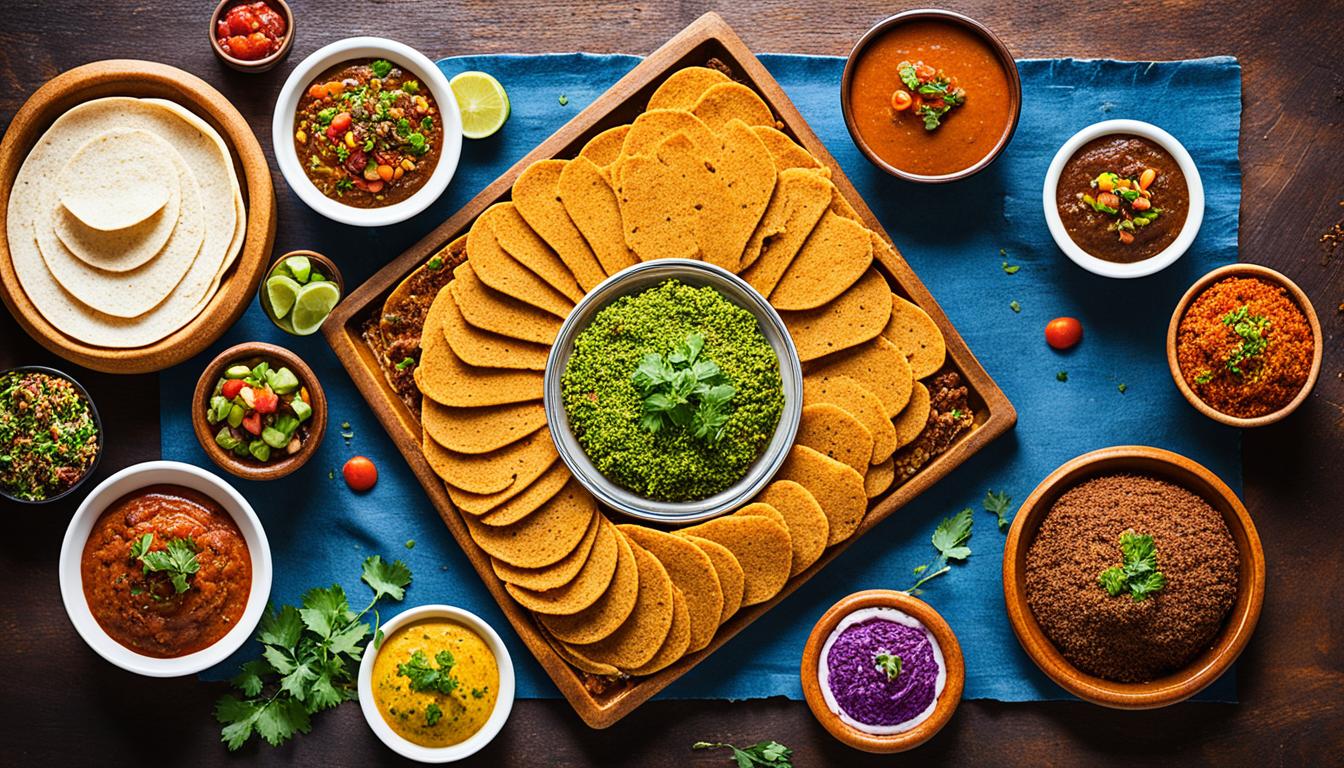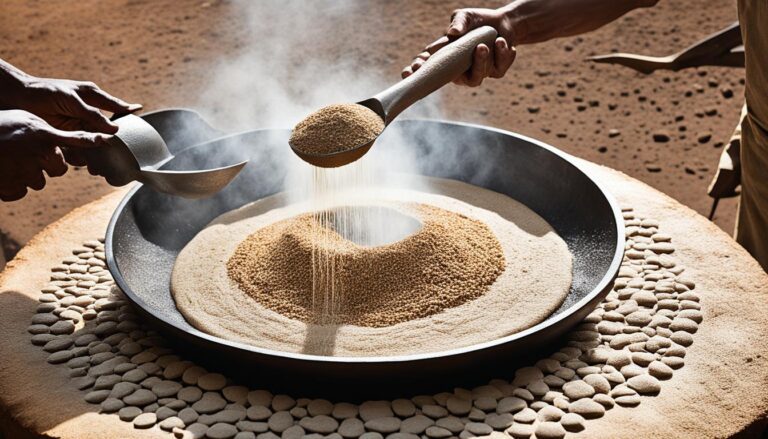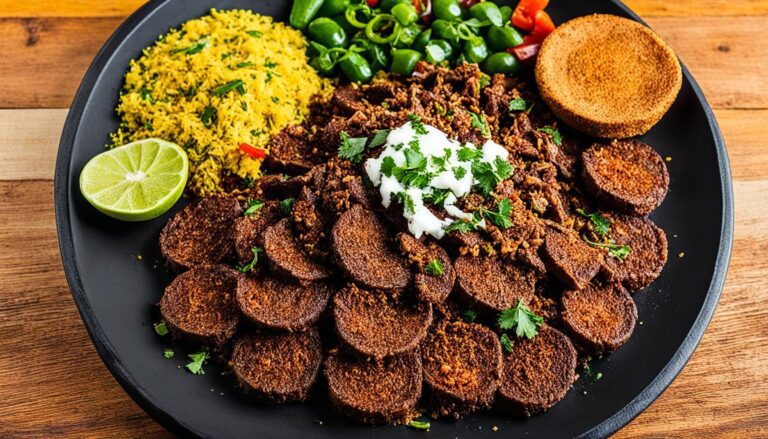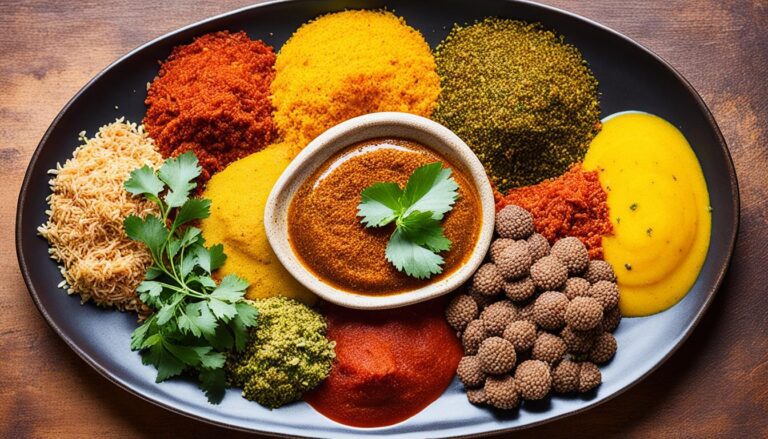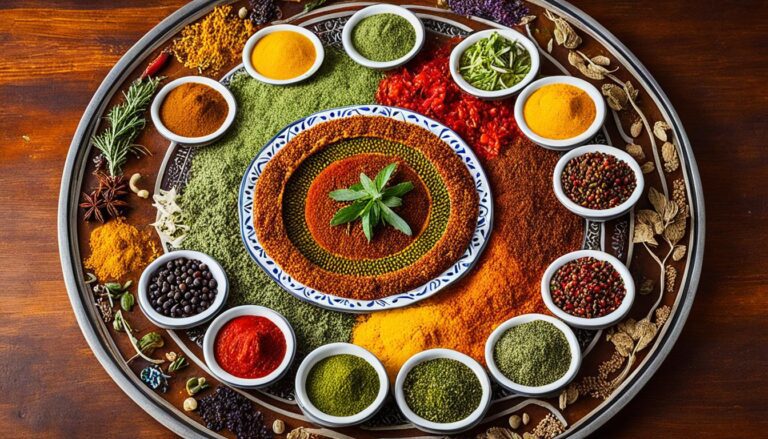What Bread to Serve With Ethiopian Food
Welcome to our guide on the best bread options to serve with Ethiopian food. When it comes to enjoying the rich and diverse flavors of Ethiopian cuisine, the right bread can make all the difference. But with so many traditional Ethiopian breads to choose from, how do you know which one is the perfect match for your meal? Let’s explore the delicious options together to find out.
Key Takeaways:
- Choosing the right bread to serve with Ethiopian food is essential for an authentic dining experience.
- Injera, a sourdough flatbread made from teff flour, is the staple bread of Ethiopian cuisine.
- Dabo is a versatile bread that can be enjoyed as both a sweet treat and a savory accompaniment to meals.
- Ambasha is a spiced bread often prepared for special occasions and holidays.
- Kitcha is an unleavened pan bread that pairs well with Ethiopian stews and sauces.
Injera: The Staple Ethiopian Bread
Injera is the star of Ethiopian breads and is often considered the national dish. This sourdough flatbread is made from teff flour, a gluten-free grain indigenous to Ethiopia. It has a unique spongy texture and slightly sour taste that complements the rich flavors of Ethiopian stews, curries, and vegetables.
Step into any Ethiopian restaurant and you’ll undoubtedly be greeted by the sight and aroma of injera. This versatile bread not only serves as a delicious accompaniment to Ethiopian dishes but also doubles as an integral part of the Ethiopian eating experience.
Here’s how it works: injera is used as both a utensil and a plate. It is the perfect vessel for sopping up stews and sauces or wrapping around flavorful meats and vegetables. Its tangy flavor enhances the overall meal, bringing a unique taste that is distinctly Ethiopian.
The process of making injera involves fermenting the teff flour batter over several days, giving the bread its characteristic sourdough flavor. Traditionally, this process is initiated by mixing teff flour and water and allowing it to ferment naturally. The resulting batter is then poured onto a hot griddle known as a mitad, where it cooks into a large, thin, and slightly porous pancake-like bread.
Injera’s unique texture and flavor make it the perfect partner for Ethiopian cuisine. As you tear off a piece of injera and scoop up a delicious bite, you’ll experience the combination of the soft, spongy bread and the bold, aromatic flavors of the dishes it accompanies.
So, whether you’re dining at an Ethiopian restaurant or cooking up an Ethiopian feast at home, don’t forget to include injera in your spread. Its status as a staple in traditional Ethiopian cuisine makes it an essential element for an authentic and flavorful experience.
Dabo: Sweet and Savory Ethiopian Bread
Dabo is a versatile Ethiopian bread that can be enjoyed as both a sweet treat or savory accompaniment to meals. Made with ingredients like wheat flour, sugar, yeast, and spices, Dabo offers a delightful combination of flavors that appeal to a range of palates. This soft and flavorful bread adds a touch of sweetness and warmth to your breakfast spread or can be paired with spicy Ethiopian dishes for a balanced and satisfying meal.
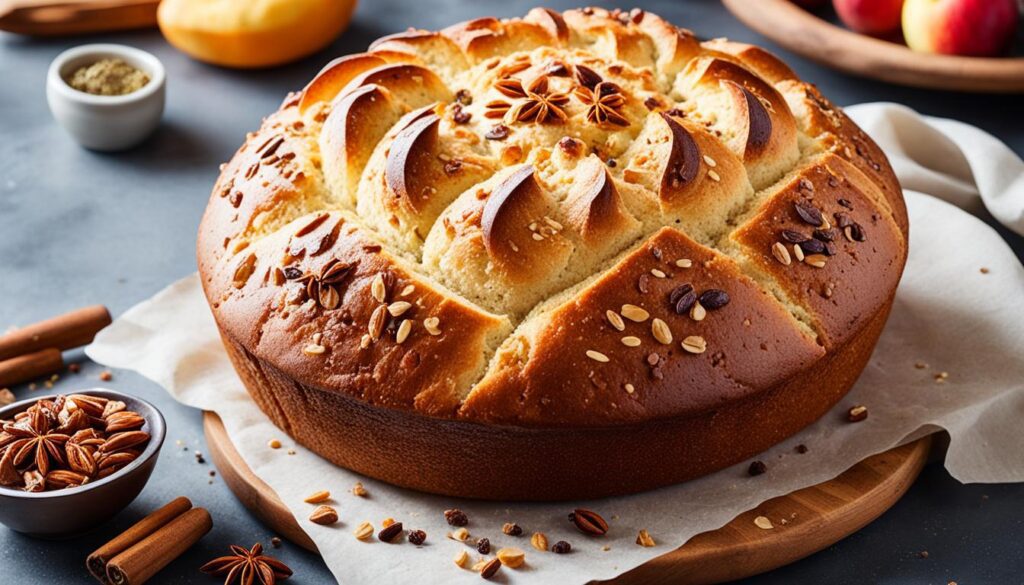
Dabo is a staple in Ethiopian breakfasts, often served with butter and honey. It provides a comforting start to the day and pairs perfectly with a cup of Ethiopian coffee. The aroma of freshly baked Dabo wafts through the air, enticing both locals and visitors to savor its delicious taste and texture.
Not limited to breakfast, Dabo can also be enjoyed alongside savory dishes, such as Ethiopian stews or curries. Its slightly sweet profile and soft crumb make it an excellent companion, soaking up the rich spices and flavors of the main dish.
If you’re inspired to try your hand at making Dabo, there are various Ethiopian bread recipes available that guide you through the process. These recipes ensure you achieve the perfect balance of sweetness and spiciness, allowing you to immerse yourself in the rich culinary traditions of Ethiopia from the comfort of your own kitchen.
Ambasha: Flavored Bread for Special Occasions
When it comes to celebrating special occasions and holidays in Ethiopia, one bread stands out – Ambasha. This festive bread is a staple in Ethiopian cuisine and adds a touch of flavor and fragrance to any gathering. Ambasha is a larger, round bread that is typically enjoyed on its own or paired with Ethiopian dishes, making it a versatile addition to any table.
What sets Ambasha apart is its tantalizing blend of spices. Often flavored with cardamom, cinnamon, or nutmeg, this bread delights the senses with its warm and fragrant aroma. Each bite of Ambasha offers a unique combination of textures and tastes, making it a delightful treat for those special moments.
Whether it’s a wedding, holiday, or any other joyful occasion, Ambasha is a beloved bread that symbolizes celebration and togetherness. Its round shape represents unity and the joy of coming together to share a meal. Just like the warmth and spices infused in Ambasha, this bread brings people closer and creates lasting memories.
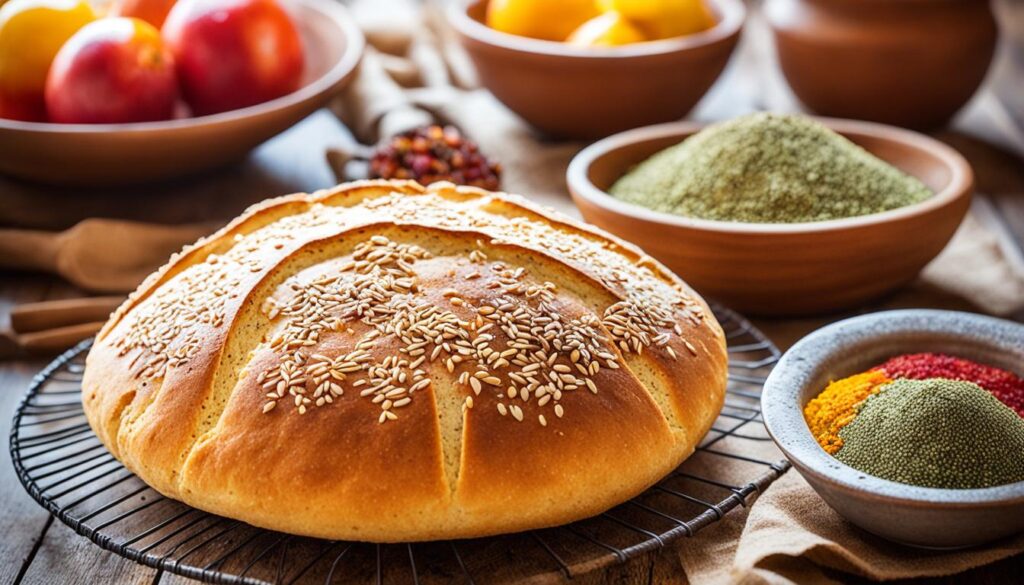
As you can see, Ambasha is more than just a bread – it’s a reflection of Ethiopian culture and traditions. It adds a touch of festivity and flavor to any special gathering, leaving a lasting impression on all those who taste it. So, the next time you’re planning a special occasion, don’t forget to include Ambasha on your menu for an authentic and memorable Ethiopian experience.
Kitcha: Ethiopian Pan Bread
When it comes to Ethiopian bread, Kitcha is a popular choice that brings a delightful crunch to every bite. Made from a simple mixture of wheat flour and water, Kitcha is an unleavened bread that is cooked on a pan or griddle, resulting in a thin and crispy texture that pairs perfectly with savory Ethiopian dishes.
With its versatility and simplicity, Kitcha can be used as a utensil for scooping up stews or sauces, adding an extra layer of flavor and texture to your meal. Its delicate nature allows it to absorb the flavors of the accompanying dishes, enhancing the overall dining experience.
To prepare your own Kitcha, you can try out the numerous Ethiopian flatbread recipes available. These recipes provide step-by-step instructions on how to achieve that perfect golden-brown crust and crispy texture that make Kitcha so irresistible.
When serving Ethiopian cuisine, don’t forget to include Kitcha in your bread selection. Its unleavened goodness and distinctive taste will surely elevate your dining experience.
Hembesha: Ethiopian Spiced Bread
When it comes to Ethiopian bread variations, one cannot overlook the delightful hembesha. Made with a combination of barley flour, spelt flour, or cornmeal, this spiced bread will transport your taste buds to the vibrant flavors of Ethiopia. What sets hembesha apart is its unique blend of aromatic spices, including cloves, cinnamon, and nutmeg, which infuse the bread with a rich and tantalizing aroma.
Hembesha is a versatile bread that can be enjoyed in various ways. Its slightly sweet and spicy taste makes it a delightful snack on its own, perfect with a cup of tea or coffee. Additionally, hembesha complements Ethiopian dishes beautifully, adding an extra layer of flavor to your meal.
Whether you’re looking to savor a piece of hembesha as a midday treat or want to enhance your Ethiopian dining experience, this spiced bread is a must-try. Its warm, sweet, and fragrant profile will transport you to the vibrant streets of Ethiopia, where bread-making traditions are deeply rooted in the culture.
Other Ethiopian Bread Varieties
In addition to the breads mentioned above, Ethiopian cuisine offers a wide variety of regional and seasonal breads. These include breads like kocho, gomen kitfo bread, and genfo bread, each with its own unique characteristics. Exploring these lesser-known breads can add an extra dimension to your Ethiopian dining experience.
Kocho
Kocho is a traditional Ethiopian bread that is made from the ensete plant (also known as the false banana). The plant’s stem and root are chopped, fermented, and then mixed to create a dough, which is then baked or steamed. Kocho has a unique texture and flavor, making it a popular choice in certain regions of Ethiopia.
Gomen Kitfo Bread
Gomen kitfo bread is a type of Ethiopian bread that is specifically designed to accompany gomen kitfo, a traditional Ethiopian dish made with minced collard greens. The bread is typically made from barley flour and has a soft and chewy texture, making it perfect for scooping up the flavorful gomen kitfo.
Genfo Bread
Genfo bread is a staple in Ethiopian cuisine, particularly during the colder months. It is made from roasted barley flour and has a thick and porridge-like consistency. Genfo bread is often enjoyed with butter, honey, or spicy stews, providing a comforting and hearty meal.
Conclusion
Choosing the right bread to serve with Ethiopian food can elevate your meal from ordinary to extraordinary. Each option brings its own unique flavors and textures, perfectly complementing the rich and spicy dishes of Ethiopian cuisine.
From the iconic injera, with its spongy texture and sour taste, to the versatile dabo, which can be enjoyed as a sweet treat or savory accompaniment, Ethiopian breads offer a range of options to suit every palate.
Don’t be afraid to explore the lesser-known Ethiopian bread varieties, such as the festive ambasha or the crispy kitcha. These breads can add an extra dimension to your Ethiopian dining experience, allowing you to savor the diverse flavors and traditions of this ancient cuisine.
So, next time you sit down to enjoy an Ethiopian feast, remember to consider the perfect bread pairing to complete your dining experience. Whether it’s the traditional injera or one of the other delicious Ethiopian breads, a well-chosen bread will bring harmony to your meal and leave you craving for more.

